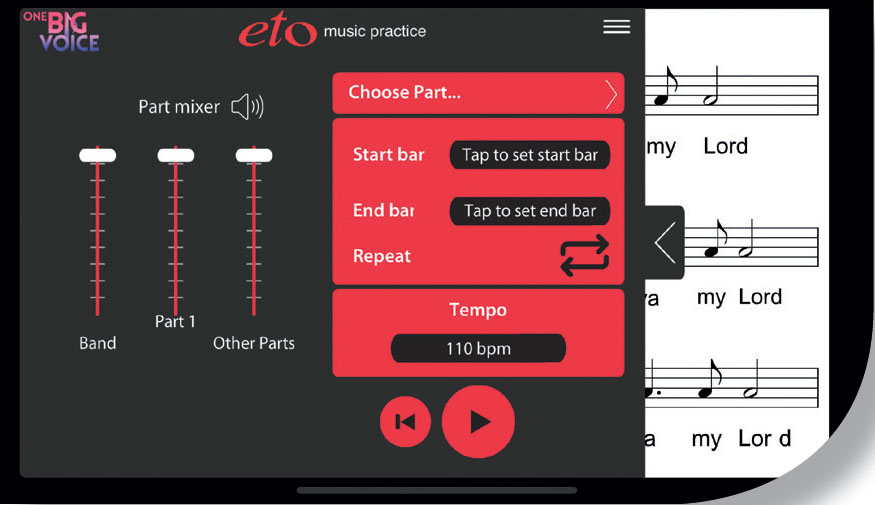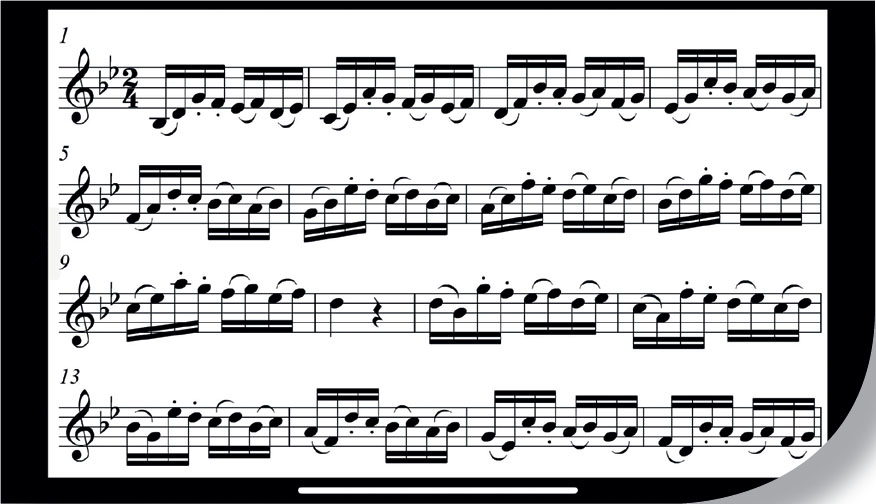
A wide range of music apps are available on the assorted mobile operating systems. One of the most common is the practice app – a piece of software running on a tablet or phone to support learning an instrument from scratch, or to aid work between lessons. It is the latter category that the apps from eto Music Practice fall.
I was provided with three of the company's apps: one for beginner recorder, one for learning the song ‘Kumbaya’ in four parts, and a technical exercise app for trumpets. I have had a good look at all three and engaged with them with varying degrees of success – entirely due to my own musical ability rather than the apps!
Recorder Level 1
I began with the recorder app because I can actually play the recorder. The app opens with the company logo on a splash screen, first in portrait mode and then landscape. This is clever because it clearly indicates that the app is intended to be run in landscape mode. I was then offered the option to pick a language between English or Welsh – another nice touch. The main app then opens with music on the right and a side bar with controls on the left. The controls are in a contrasting red and black colour scheme which works perfectly well on my phone, but I'm not sure how clear it would be if connected to a projector in direct sunlight as eto suggests it could be.
The Recorder Level 1 app has been developed for students to use between lessons. The pieces are all based around B, A, G and range from using one pitch and two rhythmic values through to all three pitches and dotted rhythms.
The interface is very straightforward. Two on-screen faders allow the user to adjust the relative volume of the melody and the accompaniment. This is useful to allow students to hear what they are aiming for and then reduce the volume of their own part as they become more confident.
The button to select the exercise is in the middle at the top of the screen. The other functions in the middle of the screen allow the user to select the bars they want to practise, from a single bar to the entire piece. There is then a repeat button and tempo control to slow down the speed of the piece to allow for more detailed practice. The two remaining controls are start and stop – self-explanatory. When one presses the play button the control window automatically disappears and music fills the screen. There is always a couple of bars’ introduction, so there is plenty of time to raise your recorder to your lips.
I played through all the exercises and they are musically very good. The accompaniments add quality and make the tasks engaging. The tracks count along with you throughout, which makes following the music very easy. The count subdivides rhythmically where needed and uses the actual numbers above the relevant notes, rather than just displaying a flashing dot in the corner.
‘Kumbaya’

The concept of this app is one I can't recall having seen much (if ever?) before. It is designed to teach a four-part vocal arrangement of ‘Kumbaya’. The user can select the part they want to follow or learn and listen to either the whole arrangement or just a single line.
This app in particular will work well when connected to a projector, allowing a non-specialist to lead a rehearsal because the whole piece can be followed on screen. Oddly, the whole score isn't a view option in the part-selection panel (it is there – but you have to go hunting in the main menu) but if the song is being learned by rote and in parts, it's unlikely that the score will be used that often.
Arban 16ths

Appropriately for this brass focus issue, the third app I looked at features technical exercises for the trumpet. I can (sort of) play the recorder and sing – but I cannot play the trumpet at all, so I had to look up the relevance of Arban (a pedagogy for teaching trumpet and cornet).
Presumably these 16th-note exercises are taken from it (or possibly inspired by it).
As with the other two apps, the metronome follows along and the volume of the trumpet part can be adjusted. This feels slightly less relevant here because there is no accompaniment, but having the functionality to bring the melody instrument in and out to check timing could be useful.
Positives
The functionality of these apps is excellent. I had never used them before and could navigate them with ease. There are no unnecessary hidden menus and the only things not on the main screen are links to the website, other apps and help functions. The sounds are excellent, and the timbres are not lowest quality MIDI sounds – a refreshing change from a lot of similar products.
Even better if…
The exercise/part selection button is very small, about the smallest button on the screen. I feel it could be afforded more real estate to make it clearer where the user selects alternate exercises.
My biggest query regarding these apps, however, is the cost. These are not expensive apps – only a few pounds each – but the amount of material the user gets for their money is not that great. There are only five exercises in the Arban 16ths and only 10 in Recorder Level 1. And obviously, ‘Kumbaya’ only has one song loaded on it. The price per exercise feels quite high when compared to an equivalent exercise book. If the app added something additional such as analysis of the performance using the built-in mic on devices, it might be different. Nevertheless, these apps work excellently.
Visit www.etomusicpractice.co.uk – prices vary depending on the app and bundles are available.




